Audigy2 Platinum eX: Top Sound Card from Creative

We are going to take a look at Creative Audigy2 Platinum eX, a model with an external communication module, which is claimed to sound much better than the regular Audigy2. Let’s check it out whether the $190 sound card aimed at music professionals and enthusiasts is a worthy product.
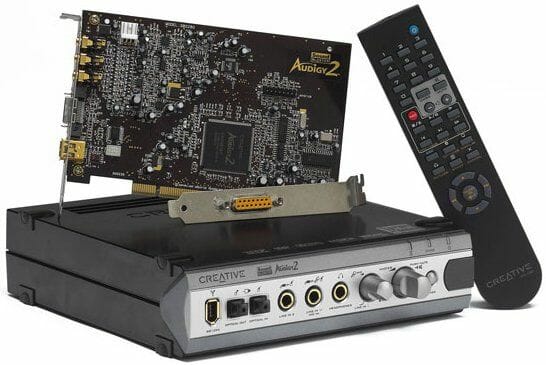
Last year Creative Labs introduced a new generation sound card called Audigy2, promising to roll out Audigy2 Platinum eX, a model with an external communication module, in the first quarter of 2003. The new year has come and we have got what we were waiting for. Company claims that this model sounds much better than the standard Audigy2. Let’s check it out. First, let’s browse through the main features of Audigy2 Platinum eX.
Closer Look: Audigy2 Platinum eX
These are the basic features of the new Creative’s sound card:
- 24bit/192kHz audio playback;
- 24bit/96kHz audio playback and recording;
- Full DVD-Audio support;
- Full ASIO 2.0 support;
- Seven-channel audio (6.1) with Dolby Digital EX decoding;
- Six analog outputs;
- Three Line In connectors;
- THX certificate;
- New sound up-mixing algorithms, CMSS 3D;
- Improved signal/noise ratio (SNR): 106dB.
The package of Audigy2 Platinum eX contains similar stuff to what comes with the sound card featuring an internal communication module. Here is what we found in the box:
- Sound Blaster Audigy2 Platinum eX audio card;
- External communication module;
- Infrared remote control, Creative RM-1000;
- Joystick/MIDI bracket;
- 1.8m cable for the communication module;
- Power cable (that comes from the PSU to the audio card);
- Digital audio cable for the CD-ROM;
- Power splitter cable;
- 6.3-3.5mm adapter (jack / mini-jack);
- User’s manual;
- CDs with demo programs and games.
Just like the ordinary Audigy2, this product comes fully supported from the software side: the Installation Kit consists of eight compact disks! This is a real bounty:
- Installation CD with the driver and accompanying software;
- Sound Blaster Audigy2 “Feature Showcase Demonstration”;
- “DVD-audio Sampler”;
- “Getting Started Demonstration”;
- Steinberg Cubasis VST Creative Edition / Wavelab Lite;
- Native Instruments Traktor DJ;
- Image-line Fruityloops 3 Creative Edition;
- Ableton Live 1.5 Creative Edition;
- Ulead VideoStudio 5;
- Soldier of Fortune II: Double Helix (full version of the game supporting EAX Advanced HD);
- Hitman 2: Silent Assassin (full version of the game supporting EAX Advanced HD).e
The software set is nearly the same as the one coming with Audigy2. The support programs haven’t changed, either. So, we won’t dwell on their functions and feature here. If you are looking for a thorough description of the software, refer to our Creative Audigy2 Platinum Sound Card Review.
Specifications
| Audigy2 audio processor | |
| Playback quality | |
| Recording quality | |
| MIDI | |
| EAX | |
| SB1394 (FireWire) | |
| Signal | |
| Supported audio standards | |
| CMSS (Creative Multi Speaker Surround) | |
| Approximate pricing |
Sound Card PCB Design
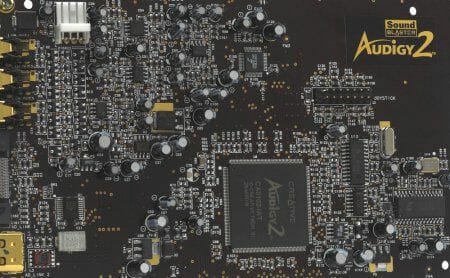
Like the whole family of sound cards from Creative, this one is made of dark-brown glass-cloth laminate and has gold-plated connectors for better conductivity. Audigy2 is equipped with a powerful CA0102-IAT digital signal processor. It replaced E-MU10K1 and inherited quite a few of its features. A glance at the card says that there are fewer details. It’s because nearly the entire analog part has been moved to the external module, while the PCB itself carries only an eight-channel Cirrus Logic CS4382 DAC (192KHz/24bit) that serves its analog outputs. This solution has its advantages and shortcomings. The negative points: the card has no internal analog (as well as digital) connectors for attaching audio devices installed inside the chassis (for example, the analog output of the CD-ROM, the audio channel of some TV-tuners). The card only has a connector onboard for additional power supply (to support FireWire devices) and a joystick connector (the bracket with the joystick port is included).
CS4382 DAC from Cirrus Logic features an analog filter system and per-channel volume control. Thanks to its adequate characteristics, it found its way into many sound cards.
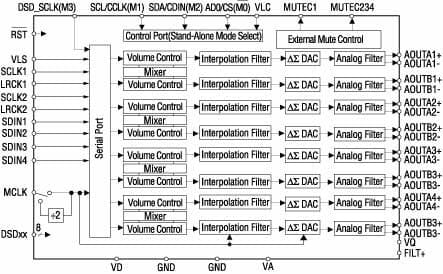
| CS4382 | |
|---|---|
| Capacity: | 24bit |
| Sampling frequency: | 192kHz (max) |
| Channels: | 8 |
| Dynamic range: | 114dB |
| THD+N: | -100dB |

The bracket of the sound card carries:
- Three mini-jacks for analog output;
- AD_LINK 1 and AD_LINK 2 – to connect the card to the communication module.
Internal connectors:
- 15-pin MIDI/Joystick connector;
- Additional power supply connector.
External Communication Module

The main purpose of the external communication module is to make it easier to connect peripheral audio devices to the computer. The module is made of black plastic and stands on four rubber legs to prevent it from sliding on the desk. You can place it either horizontally or vertically. By the way, the module resembles very much the appearance of the external Extigy sound card.
IEEE1394-compatible devices (digital camcorders and cameras, printers and scanners) can be plugged into the SB1394 interface port on the front panel of the module. Besides, the front panel carries connectors for those devices that are used most often. In fact, the external communication module is quite a unique thing as it has three analog inputs (two are in the front, the remaining one – at the back). The Line 1 input is shared with the microphone input (we saw this solution in all the previous versions of communication modules); the signal source are shifted with the microphone input volume switch. By the way, the card’s package includes a jack / mini-jack adapter to connect various audio appliances.
While the first line-in can be used for the microphone, the second can be used for such line sources as music synthesizers or household electronic appliances. The third line input (Aux In) is formed by two RCA sockets for the right and left channels and is intended for analog devices like a TV-set, VCR, CD-player and so on.
Actually, it’s rather a strange solution to place all analog inputs on the communication module, while all analog outputs remain on card. It would be more logical to place all the analog stuff in one location. Still, the manufacturer must have had some reasons for it.

It is very convenient that we have an overall digital volume control on the front panel (the sound volume changes discretely, without mechanical limits to either side). A little to the left from the IR-receiver, there is a button to activate CMSS mode (Creative Multi Speaker Surround). When the card is in this mode, it splits stereo sound among all the components of the speaker system. Besides the above-described communication means, the front panel also carries an optical input and output.
So, the front panel of the communication module accommodates:
- SB1394 (FireWire);
- Optical SPDIF in/out;
- Line In 1 (1/4” Stereo-Jack combined with a microphone input with additional gain control);
- Line In 2 (1/4” Stereo-Jack);
- Headphones output (1/4” Stereo-Jack).
Besides the third Line In we’ve mentioned above, the back panel of the module has a lot of interesting things. First, there is a coaxial digital input and output as well as a composite digital output for plugging in a speaker system of the MegaWorks 610D type. Second, there are two full-size MIDI sockets (a lot of free space allows placing them instead of mini-MIDI connectors). Third, the FireWire port is doubled at the back panel. The module is connected to the sound card via AD_LINK 1 and AD_LINK 2 connectors (an adapter connector for FireWire).
So, the back panel of the communication module carries:
- Line In 3 (2x RCA Jack);
- Coaxial SPDIF In/Out;
- Digital Out supporting six-channel (5.1) speaker systems from Creative;
- MIDI input and output;
- AD_LINK 1 and AD_LINK 2 for connecting the module to Audigy2.
When I opened the cover, I saw a metal bar at the bottom of the module making the whole thing heavier.
Now, let’s discuss the electronics placed inside the module. Nearly all the analog things are here (the card itself has only a circuitry for analog outputs to speaker systems). You may remember that the Platinum model with an internal communication module used AC’97 codec SigmaTEL STAC9721 to serve the analog part. It was the company’s choice since Live!. But in our today’s hero Creative put its stake onto high-quality PCM1804 ADC from Texas Instruments (www.ti.com). These chips coupled with low-noise operational amplifiers are responsible for all the three analog inputs of the communication module. The Texas Instruments website has a detailed description of this ADC. These are the main characteristics of PCM1804:
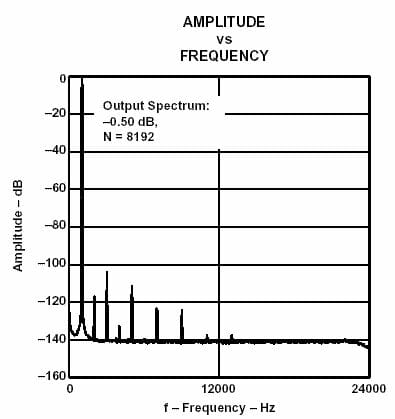
The graph shows that there is a very low harmonics level when the peak of the effective signal is 1kHz. That testifies high quality of the codec. Our tests will show how well Creative used its potential.
CS4392 chip from Cirrus Logic serves as a digital-to-analog converter. The characteristics of this chip match those of PCM1804 ADC:
- Up to 192KHz sample rate;
- 114dB dynamic range;
- THD+N: 100dB.
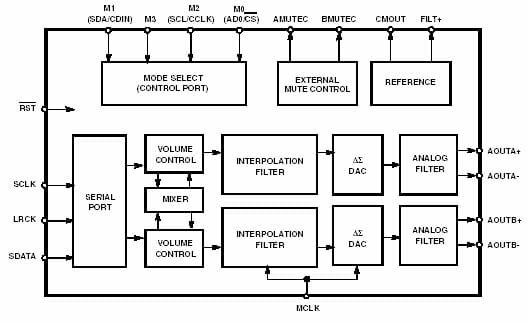
You see a flow-chart for CS4392 DAC. Note that the codec features separate volume regulation scheme, which stands before the digital-to-analog conversion. The volume is controlled discretely with 1dB increment, which is done with the digital volume regulator on the front panel of the communication module.
Tests
The two models – Audigy2 and Audigy2 Platinum eX – are both based on the same sound processor, CA0102-IAT, but, although their names differ only by a short index they are based on different element base. That’s why we tried to compare the cards against one another. Moreover, we also considered the data for TerraTec Aureon 7.1 Space, just not to limit ourselves with Creative products only.
We tested Audigy2 Platinum eX in SpectraLAB (v.4.32.17) utility following the methodology described in our previous reviews as well as the recommendations of Creative Labs to tests like that. The results shown refer to the LineOut 1 – LineIn 3 circuit.
Creative Audigy2 Platinum eX Spectrograms:
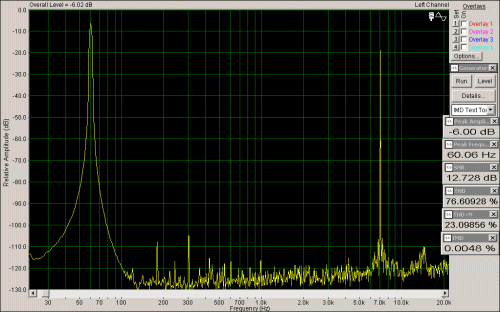
| Creative Audigy2 | TerraTec Aureon 7.1 Space | Creative Audigy2 Platinum eX | ||||
|---|---|---|---|---|---|---|
| 44,100Hz / 16bit | 48,000Hz / 16bit | 44,100Hz / 16bit | 48,000Hz / 16bit | 44,100Hz / 16bit | 48,000Hz / 16bit | |
| SNR, dB | 90.114 | 90.322 | 93.13 | 93.071 | 90.589 | 91.858 |
| THD, % | 0.00203 | 0.00422 | 0.00157 | 0.00194 | 0.00182 | 0.00268 |
| THD+N, % | 0.00312 | 0.00384 | 0.00221 | 0.00222 | 0.00295 | 0.00255 |
| IMD, % | 0.0202 | 0.0078 | 0.0044 | 0.0039 | 0.0049 | 0.0048 |
The results suggest that the top-end Audigy2 Platinum eX has a certain advantage over the ordinary Audigy2. At the same time, we see a notable lag behind the recently-tested TerraTec Aureon 7.1 Space.
If we visually compare the spectrograms of the standard Audigy2 and Audigy2 Platinum eX, we will notice some reduction of the overall noise level by the new card, although it is not a very significant reduction. The signal-to-noise ratio has improved just a little due to the high peaks in the third and fifth harmonics. On the whole, the new card from Creative showed (or sounded) nothing exceptional.
Conclusion
So, we have just taken a look at the new sound card from Creative. We saw that this product has a high-quality hardware part that helped it pass our tests with honor. As for the software, it is up to the mark, too (I guess many users will appreciate the professional Cubasis VST program). The sound card with an external communication module is the top-end product from the company and is mainly targeted, quoting Creative, at users that are seriously into music. Nevertheless, Audigy2 seems to be a thing for enthusiasts rather than professionals. In my opinion, people who work with music won’t take this card seriously. It will only serve to connect musical instruments to the computer. The point is that Audigy2 Platinum eX, unlike truly professional cards, doesn’t have balanced ins and outs, and the output signal level is only –10dB.
Of course, we can also harangue about the main disadvantage of this card – its price. We can continue complaining about the permanent lack of finances and think of those many useful things we could buy for $200. But we can take another point of view: an Audigy2 buyer gets a huge software bundle and a kind of external FireWire controller to connect a DV camcorder or scanner, an external hard disk drive or memory card reader, or anything else.
Those who don’t need all these accessories can just buy the card in the simple version (without the communication module). Audigy2, as it is, costs about $100. Thus, it’s quite affordable for anyone who wants to have a really high-quality sound card. By the way, for the most economic (or money-tight) users Creative makes a special offer: you can buy Audigy2 with Creative Inspire 6.1 6700 speaker system and it will cost you less than purchasing them separately.
Highs:
- Good sound quality;
- DVD-Audio support;
- 24bit/96kHz recording;
- 24bit/192kHz playback;
- Seven-channel audio (6.1);
- ASIO 2.0 (24bit/96kHz) support;
- Six analog inputs;
- Large software bundle.
Lows:
- High price;
- Non-balanced ins and outs;
- Insufficient signal level: –10dB;
- No internal connectors on the card.